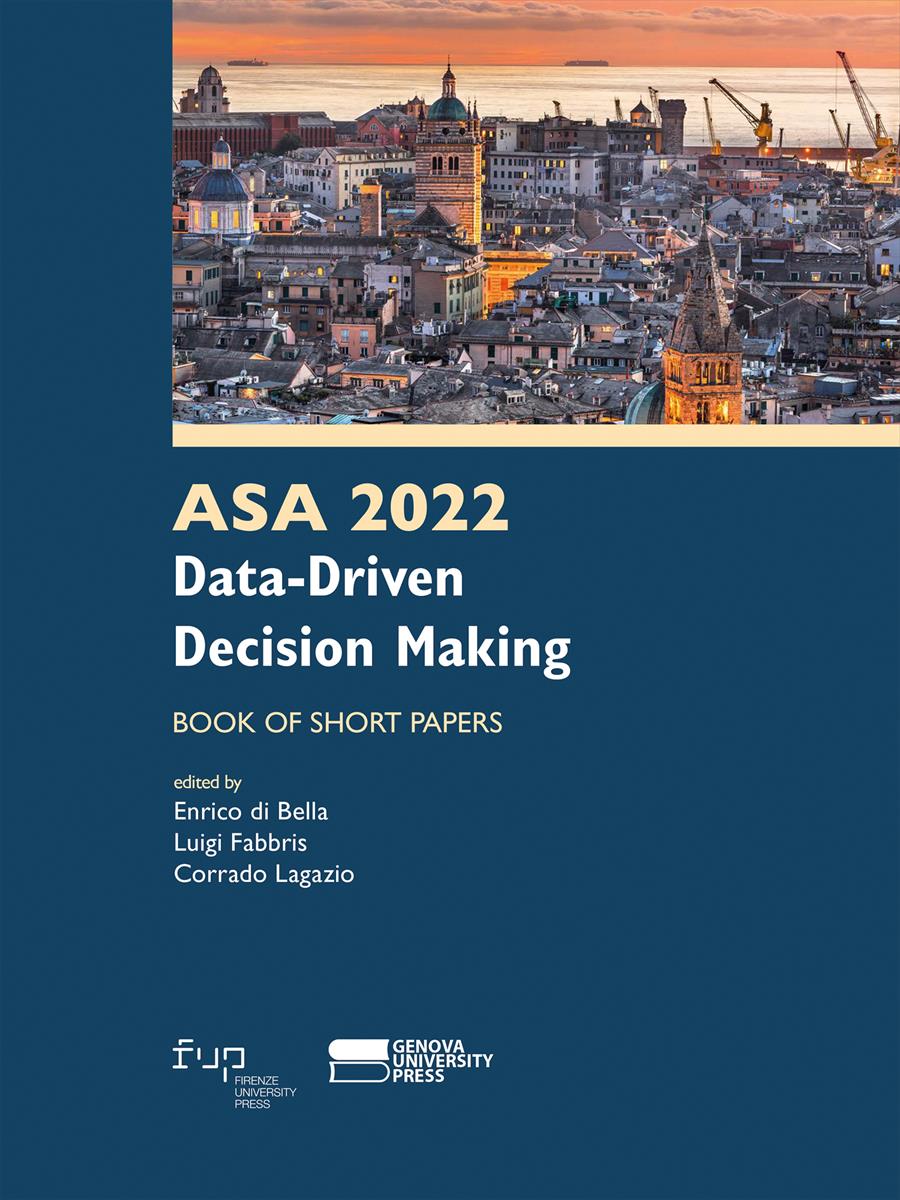- ASA 2022 Data-Driven Decision Making
- Edited by Enrico di Bella, Luigi Fabbris, Corrado Lagazio
Assessing intimate partner violence in African countries through a model-based composite indicator
- Anna Maria Parroco
- Micaela Arcaio
- © 2023 Author(s) |
- CC BY 4.0
- DOI: 10.36253/979-12-215-0106-3.35
Violence against women has been recognised to affect all dimensions of women’s lives and health, involving both the physical and mental conditions of victims and their general well-being. Intimate partner violence (IPV) – characterized by one of the partners seeking power and control over the other – can be identified as either emotional, physical, or sexual abuse. Recent data show that 33% of ever-married women in Sub-Saharan Africa have survived this form of abuse. The literature lacks an overall measure of violence suitable for surveys since the Composite Abuse Scale (Revised) – Short Form captures IPV mostly in a clinical setting. The data here used are drawn from the Demographic and Health Survey (DHS). They are part of fifteen surveys that include a module on domestic violence and were carried out in African countries mostly from 2015 to 2018. All women selected for this sample are married women, aged 15-64. Three logistic regression models were previously defined to investigate the determinants of physical, emotional and sexual abuse - independently. In these models, the history of violence – defined as witnessing parental violence, rape by a man other than her partner, and number of abusers in life – turned out to be crucial in predicting violence itself. The intensity of how justified wife-beating is by women themselves and the number of control issues also resulted as significant across all models. On the other hand, the partner’s high education and higher wealth turned out to be protective factors. On these bases, the definition and construction of a composite indicator of IPV with a Structural Equation Model (SEM) are already underway. The possibility of ranking the units of analysis according to the level of the IPV indicator can allow governmental and non-governmental organizations to implement socio-educational interventions that are better targeted to the actual needs of each context.
- Keywords:
- Intimate Partner Violence,
- Demographic and Health Survey,
- Composite,
University of Palermo, Italy - ORCID: 0000-0003-3213-7805
University of Palermo, Italy - ORCID: 0000-0001-6149-7784
- Arcaio, M., Mendola, D., Parroco, A.M. (2022). Domestic Violence in Africa: A Glance Through the DHS Survey, Book of the short papers of the 51st Conference of the Italian Statistical Society, Pearson, 1112-1117.
- Classen, C. C., Palesh, O. G., & Aggarwal, R. (2005). Sexual revictimization: A review of the empirical literature, Trauma, Violence, & Abuse, 6, 103–129.
- Gilboe, M., Wathen, C., Varcoe, C., MacMillan, H., Scott-Storey, K., & Mantler, T. et al. (2022). Development of a brief measure of intimate partner violence experiences: the Composite Abuse Scale (Revised)—Short Form (CAS R -SF). BMJ Open 2016;6:e012824. DOI: 10.1136/bmjopen-2016- 012824
- Heirigs, M., Moore, M. (2017). Gender inequality and homicide: a cross-national examination, International Journal of Comparative and Applied Criminal Justice, 42(4), 273-285. DOI: 10.1080/01924036.2017.1322112
- Meinck, F., Cluver, L. D., Boyes, M. E., & Mhlongo, E. L. (2015). Risk and protective factors for physical and sexual abuse of children and adolescents in Africa: A review and implications for Practice, Trauma, Violence, & Abuse, 16, 81–107.
- Muthén, B. (1984). A general structural equation model with dichotomous, ordered categorical, and continuous latent variable indicators, Psychometrika, 49(1), 115–132. DOI: 10.1007/bf02294210
- Oyediran, K. and Feyisetan, B., 2017. Prevalence and contextual determinants of intimate partner violence in Nigeria. African Population Studies, 31(1).
- United Nations, What Is Domestic Abuse? https://www.un.org/en/coronavirus/what-is-domestic-abuse. Published 2022. Cited 13 Feb 2022.
- World Health Organisation. Violence Against Women Prevalence Estimates, 2018: Global, Regional and National Prevalence Estimates for Intimate Partner Violence Against Women and Global and Regional Prevalence Estimates for Non-Partner Sexual Violence Again
Chapter Information
Chapter Title
Assessing intimate partner violence in African countries through a model-based composite indicator
Authors
Anna Maria Parroco, Micaela Arcaio
Language
English
DOI
10.36253/979-12-215-0106-3.35
Peer Reviewed
Publication Year
2023
Copyright Information
© 2023 Author(s)
Content License
Metadata License
Bibliographic Information
Book Title
ASA 2022 Data-Driven Decision Making
Book Subtitle
Book of short papers
Editors
Enrico di Bella, Luigi Fabbris, Corrado Lagazio
Peer Reviewed
Publication Year
2023
Copyright Information
© 2023 Author(s)
Content License
Metadata License
Publisher Name
Firenze University Press, Genova University Press
DOI
10.36253/979-12-215-0106-3
eISBN (pdf)
979-12-215-0106-3
eISBN (xml)
979-12-215-0107-0
Series Title
Proceedings e report
Series ISSN
2704-601X
Series E-ISSN
2704-5846
